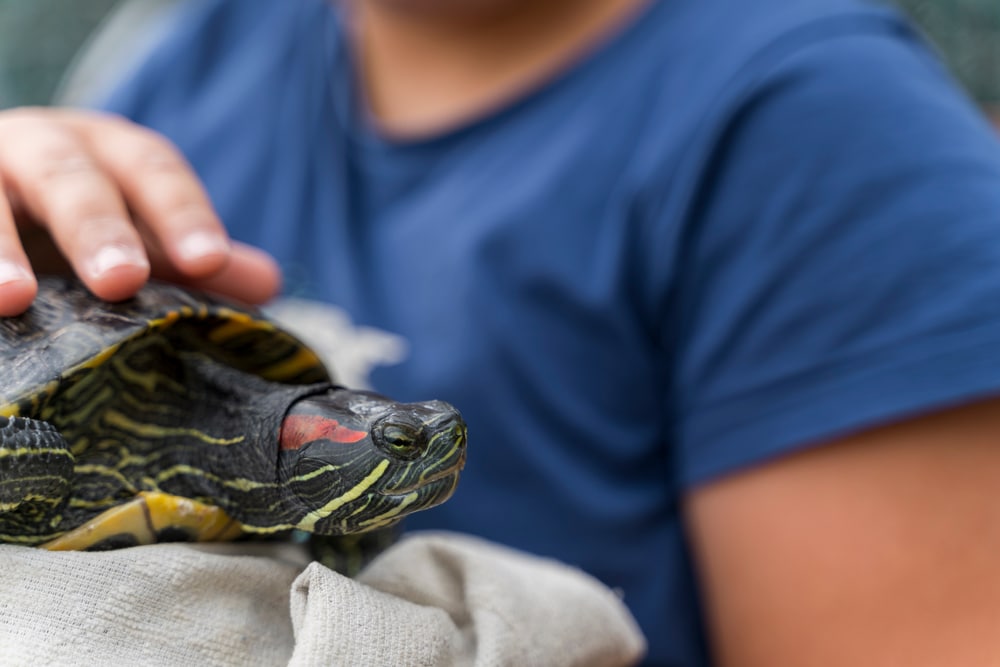
For individuals looking for an exotic animal that is relatively easy to care for and surprisingly long-lived, look no further than the box turtle. Over 4 million American households have welcomed reptiles into their homes. While turtles are not cuddly like dogs, they can still make excellent pets that can provide years of enjoyment for you and your children.
Box Turtle Facts
Box turtles, like tortoises, are land-dwelling animals, with a few exceptions. There are six species and several subspecies native to North America, mainly found in warmer regions. Scientists have formally identified and classified them since the mid-1700s. It didn’t take long before they made it into people’s homes because of their docile nature.
Even though you can find box turtles in the United States, many states prohibit capturing live animals. Some species, such as the Eastern Box Turtle, have been decreasing in recent years, prompting the International Union for Conservation of Nature and Natural Resources to classify them as a vulnerable species.
The box turtle gets its name from its shell, into which it can retract its limbs and head to avoid predators. The top part is called the carapace, and the bottom is the plastron. Most species grow between 4 to 6 inches. They can live quite a long time with proper care, with some living 50 or even 100 years!
Unlike for many pets, the FDA regulates the sale of turtles to only those with carapaces over 4 inches. The primary concern is salmonellosis, particularly with aquatic turtles. Some states, such as New Hampshire, require permits to keep them as pets. Others, like Wisconsin and Arizona, ban them outright.
- Related Read: How Big Do Box Turtles Get? (Size & Growth Chart)

Do Box Turtles Make Good Pets?
As far as care goes, box turtles tick off multiple boxes for good pets. They are quiet. They don’t need daily walks. The primary considerations are a proper cage set-up and a varied diet. It’s vital to remember that box turtles are essentially wild animals, even the ones that you buy at pet stores. They don’t handle change or stress well. Some don’t like handling.
Our advice is to get a box turtle as a pet for older children or adults. Younger kids are more likely to handle them excessively. They are also more vulnerable to contracting salmonellosis, particularly if they don’t wash their hands after touching the turtle. Nevertheless, it’s imperative for any pet owner to take this simple precaution.
Where Can I Get a Box Turtle?
You’ll likely find limited availability of box turtles. Species that you may see include the Three-Toed Box Turtle, the Ornate Box Turtle, and several non-native species. Pet stores are your most affordable option. You can also purchase them online. We suggest researching any species that you’re considering to create the optimal habitat for your reptilian friend.
It’s worth noting that several states ban breeding box turtles. The concern rests with the impact on native species, especially where numbers are decreasing. We recommend only buying from reputable sellers who can offer a health guarantee. Box turtles will need several days to acclimate to their new surroundings, so it makes sense to get an animal from these dealers.

How Much Does It Cost to Own a Box Turtle?
The price of a box turtle will vary, depending on the species and its rarity. You can typically find common ones under $100 at pet stores. More exotic animals can run well over that amount and into the four figures. Of course, that only scratches the surface of the expense of getting a box turtle. The average cost will run about $500 annually.
The first year will be the most expensive because you’ll have to buy a cage and supplies. You should get a minimum of a 40-gallon tank if you’re going to keep your pet indoors. You can easily plan on over $200 to set up a cage with everything that your box turtle will need. When deciding where to put its home, bear in mind that it will need heat and UV light sources.
The other thing that you should consider is finding a veterinarian who specializes in turtles. These animals can carry other diseases and parasites that can spread to humans. That makes deworming them a priority for any pet owner. We recommend annual vet exams to ensure the safety of both your pet and members of your household. These will likely run about $100 or more.
What Kind of Home Does My Box Turtle Need?
A tank is an ideal cage for a box turtle. It’ll make cleaning easier and create less mess in the surrounding area. Contrary to popular belief, turtles can scoot if they need to catch prey. You can find kits for reptiles that will include most things that you need. However, you might find that buying the pieces individually is a better value in the long run.
Substrate
You’ll need a substrate on the bottom of the cage to provide humidity and a place for your box turtle to dig. Opting for something that replicates their natural environment is the best way to go. You can use coconut fiber or husks mixed with sand. You can even get topsoil or peat moss. These choices will hold moisture to keep the humidity at optimal levels.

Light and Heat
You’ll also need a UV light so your box turtle can synthesize vitamin D. You can use an aquarium light to cover the entire top if you have other curious pets in the house. Otherwise, a UV lamp will suffice. Keeping it on for 12 hours a day will replicate living conditions in its habitat. Bear that in mind when you decide where to place the cage.
Heat stones are suitable things to add to the tank. The body temperature of reptiles reflects their ambient conditions. A heat or basking stone can help your pet regulate its temperature to keep it active and healthy.
We also suggest adding décor to give your box turtle places to hide. Remember that its instinct will be to take cover if it gets stressed. That’s especially true with animals that are also prey species.
Food and Water
You should provide shallow bowls for both food and water. They’ll help keep the cage bacteria-free and prevent your pet from eating its substrate. We suggest getting dishes that are easy to clean because you will be offering your turtle a variety of foodstuffs. Make sure to give it fresh water every day.
What Should I Feed My Box Turtle?
Box turtles are omnivores that are also opportunistic. They’ll eat whatever they can find in the wild. That includes vegetation, insects, worms, and other invertebrates. You can feed your pet a variety of fresh fruits and vegetables, supplemented with crickets, mealworms, and pinkies for protein sources. The optimal diet for your box turtle will provide up to 25% protein, 6% fat, and 35% fiber.
We suggest varying your pet’s protein sources to mirror what it would eat in the wild. Prey species differ in the nutrients that they need. A varied diet will ensure that its needs are met. That also applies if you feed your pet a commercial product. Scientists haven’t researched the nutrition needs of reptiles as closely as those of other pets.
Unlike humans, many reptiles synthesize vitamin C, so there’s no need to supplement it. Offering fresh produce will ensure that it gets adequate amounts. The other concern is vitamin D, which the UV lamp or unfiltered sunlight will provide.

How Do I Take Care of My Box Turtle?
The main thing is creating a healthy environment and feeding your box turtle a high-quality diet. Remove any uneaten food promptly to avoid bacteria development. That’s especially true with any protein sources that you offer your pet.
Diet
Since vegetation will provide the bulk of your pet’s diet, it’s essential to provide fresh food and water every day for younger animals. You’ll likely find that adults may eat less often, especially if you’re giving them protein sources. Box turtles have a sharp beak that will help them rip their food apart into manageable chunks, but you should still make sure to rinse any produce and cut them into smaller pieces.
Box turtles are diurnal, or active during the daylight hours. Consequently, they do best with morning feedings. You’ll notice that your pet may act lethargic when you first turn on the UV light in the morning. As soon as its cage warms up, its body temperature will rise and get it moving.
Cleaning and Bathing
Keeping the substrate clean and damp is vital for these reptiles. We suggest that you mist it every day to maintain the 60% humidity that your box turtle prefers. However, some species, such as Ornate Box Turtles, do better in the 80% plus range.
These pets are almost maintenance-free as far as cleaning and bathing are concerned. However, we recommend trimming their toenails occasionally.
Handling
You should only handle your box turtle when necessary for maintenance or cleaning its cage. Bear in mind that these animals can and sometimes do bite. Always wash your hands after handling your pet or cleaning its cage.

How Do I Know if My Box Turtle Is Sick?
A change in appetite is a reliable indicator that something is wrong, no matter what pet you have. It’s an excellent reason against free-feeding your pet, so you can gauge how much it eats and get a heads-up when something is wrong. Inactivity or lethargy is another red flag. Animals that are sick will conserve energy to focus on fighting an illness and healing.
Illnesses for which box turtles are vulnerable include:
Maintaining adequate humidity levels will help prevent respiratory issues, while sufficient UV light can control metabolic and shell disorders.
Conclusion
Box turtles make fascinating pets that can put you in touch with nature in ways that many other animals cannot. Not too many pets have the long lifespan of these reptiles. Providing enough warmth, humidity, and a healthy diet will help ensure a good quality of life. While it may not greet you like a puppy, these animals make excellent choices for teaching your children responsibility.
Featured Image Credit: Luiza Kleina, Shutterstock










